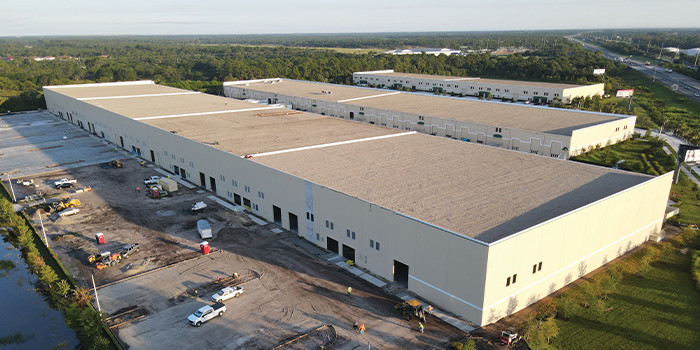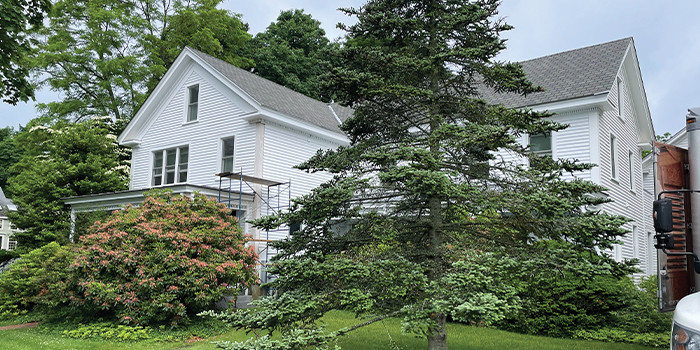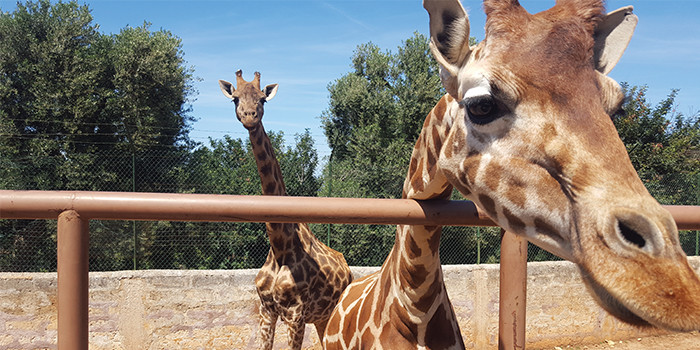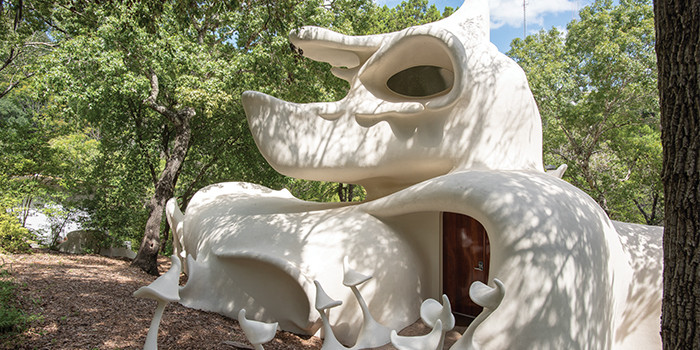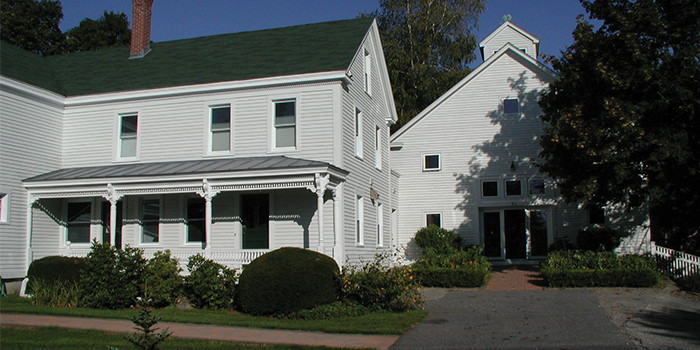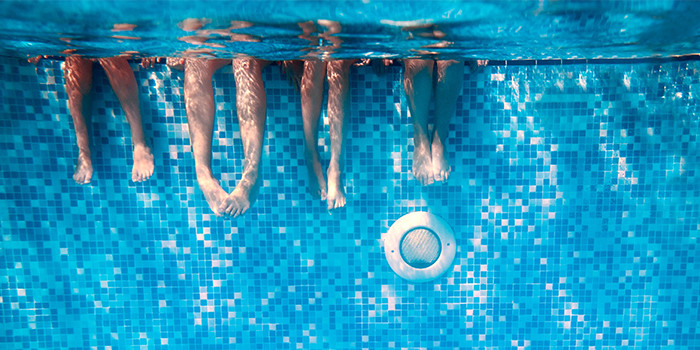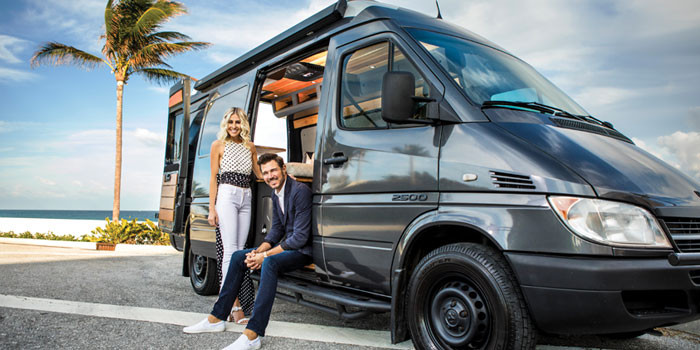
Sprinting Up The Coast

SPRAY FOAM MAGAZINE – Show Issue 2021 – Scott Carey and his wife Leah Logue are a couple without much downtime on their hands, but like many during this pandemic, they too needed time to think and adapt to an unprecedented situation. How did they achieve this? They bought an old Mercedes Sprinter van, renovated it with the help of SPF, and traveled up the East Coast of the U.S.
Meeting Scott and Leah for the first time, one is amazed with their good looks, charm, and style. With Scott being a successful former model, and Leah a platinum blond with a quick wit and warm smile, this couple has a lot more going on than meets the eye.
Scott and Leah were both raised in the heat of the South Florida sun. Scott, a fourth-generation Floridian and Leah second-generation, they are often recognized in Palm Beach County as a ‘power couple.’ Scott is a real estate broker and an owner of Palm Group Realty, a luxury real estate and tailor made estate management company. Leah is a businesswoman in her own right, owning and running Logue Decorators, where she has extensive knowledge of custom decor and construction, applying these skills on Scott’s new project.
Scott’s son was looking for a car and asked his father to come with him to check out a vehicle, “This particular car was not suitable for my son, but the guy selling it also had two Sprinter vans in his driveway and they were both for sale. I asked the guy how much he wanted for one of the vans, and thirty minutes later I was driving it home,” laughs Scott.
The couple desperately wanted a vacation, but due to COVID-19, they didn’t feel comfortable traveling via plane or boat. Scott had not planned on getting a van that day, but according to Leah, he had brought the subject up previously. She states, “I really wasn’t into the idea. Then COVID happened and traveling took a pause and this was the only real way I could see that we were going to travel.”
Scott describes himself as being a ‘technical kid’; “I would play with batteries and little motors, building Lego cars that actually ran with power. From that, I moved into radio-controlled aircraft. I started building them from scratch and making them fly. I always loved to control things—build and control.” Scott’s love of building as a youngster progressed to flipping houses with Leah, in between running their businesses. The van was something different, but it was within the same mindset. Scott goes on to say, “For me the element of excitement for the van project was to build something, for it to work, use it, and once I got bored, sell it, and move onto the next project.”
Leah was really impressed with Scott’s handywork emphasizing, “What got me was for him to build it, he had to plan out the use of it before he even started thinking about the materials, like the insulation or where he wanted the lights to go.”
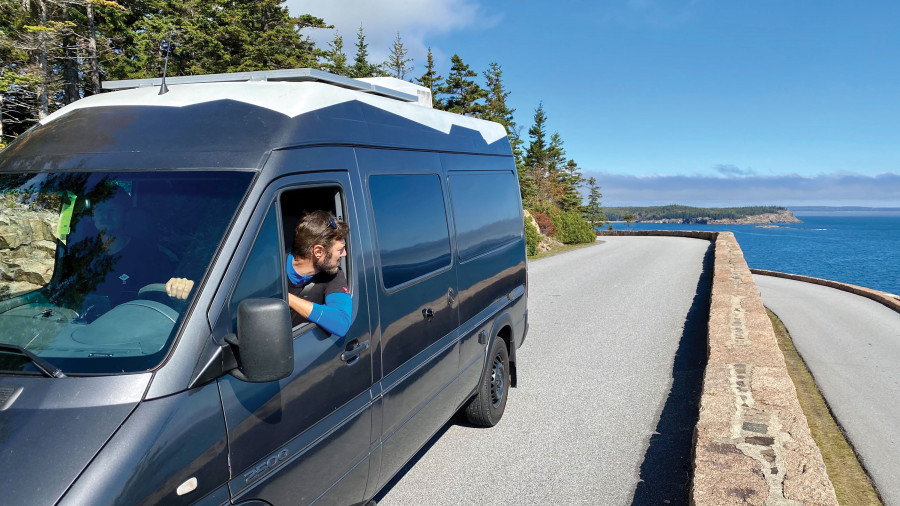
The van project was a first for Scott and he didn’t have a shop, so he just had it parked in their driveway. Scott describes himself as ‘very detail oriented’, so he took his time with the project. “Something which could have taken a month, took me about two and a half months. I took my time, and I didn’t need to rush. It really was a labor of love.”
Scott did roughly six electrical schematics and thoroughly researched controllers and inverters for the battery bank system. He also had to make sure the length of the wire was correct for the right gauge, depending on routing and the wattage traveling through it. Scott stresses, “If this is not correct, you could very easily have an electrical fire.” He also had multiple chargers for a battery bank system for the solar panels. It took Scott several attempts to perfect and now that he’s done it once, he has no doubt that it would take him half the time to complete when he takes on his next labor of love.
Scott highlighted that the use of spray foam insulation was a major part of the build, “In South Florida, it can be ridiculously hot, especially inside a metal container, which is basically what a Sprinter van is. The heat that can build up inside can be unbearable.”
The first thing Scott did was to paint the ceiling white and the exterior roof, ‘like a white covered mountain top’, as described by Scott. He went on to clarify, “That helped reflect away temperature and once we had our wiring plan and knew where things were going to come in, like holes to be drilled etc., then we started the spray foam process.”
Except for the flooring, Scott used Dupont’s Great Stuff, Gaps & Cracks, spraying three to four inches of foam. This hand sprayed foam is recognized as a fireblock, meaning it resists the free passage of flames to other areas of the building, or in this case the van, through concealed spaces. The foam expands to take the shape of cracks and voids, forming an airtight and water-resistant bond to wood, metal, masonry, glass and most plastics. Great Stuff Gaps & Cracks Insulating Foam Sealant is also an effective air sealant.
The interior materials which included quarter-inch thick wood panels, carpet, and more were chosen by Leah for the aesthetic appeal. Scott went through around 40 cans of foam, “I sectioned the van out into panels and went back and forth with the foam in small runs. I then waited as it really expands, I would say about 12 times what you originally put down. In the end it was pretty rigid, so it was perfect for holding the wires in place really well.”
Scott took wood-work classes in high school and built on the skills he learned there to construct the wooden cabinets for the van. Leah pitched in with her design skills, “I loved helping with the design, but the build was all Scott.”
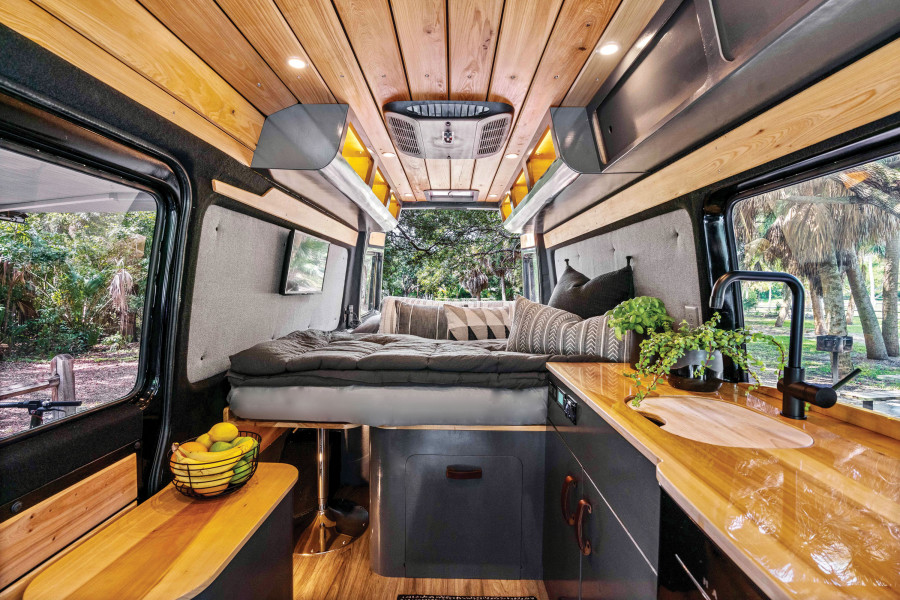
The van is an eco-van with a composting toilet, which Leah was quick to point out, ‘they never actually had to use’ and solar panels which Leah and Scott used to charge their electric scooters during the daytime.
Interstate I-95 is roughly 2,000 miles from Tequesta, South Florida to Maine. Leah and Scott shared the driving, and they loved the fact they had the freedom to be spontaneous, stopping off when they saw something interesting. The space was small but very comfortable, with the help of the foam keeping it cool in the Florida heat and cozy in the cool nights of the North.
Scott described how well the spray foam performed on the trip, “One night we were off-grid and the temperature fell to about 30° F. We had the heat on for a little and then turned it off for the night. In fact, that night we chose to sleep in the van over a hotel room just because it was so comfortable.” Leah laughed and commented, “Another night we did stay in a hotel in Vermont, and we both looked at each other and said, ‘we wish we were back in the van.’”
Scott reflects on the journey, “The biggest reward for me through the entire trip was the fact the van, and all the materials I used, performed exactly the way I wanted them to. The van project was a great way to explore the living off-grid lifestyle and with that comes efficiency through the materials I used like spray foam and solar energy.”
The pandemic has brought hardship for many, but having restrictions can also give people the opportunity to press the reset button and activate their creative mind. Disciplines including business, art, science, medicine and architecture have been given a kickstart. Similar to the creativity during a war, COVID-19 is, and has been, a platform to reimagine the future.
The use of materials like SPF enables people to practically apply their dreams, like a quarantine, eco-friendly van that provides the freedom to be self-sufficient on the open road.

